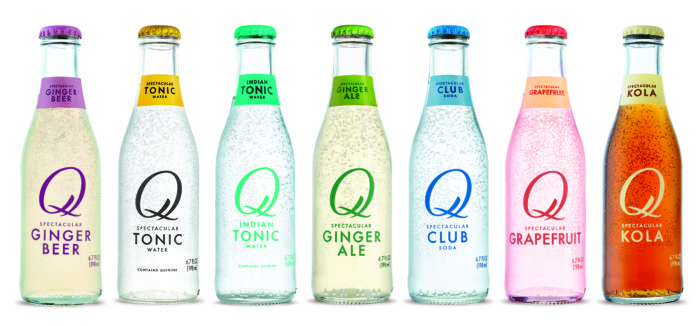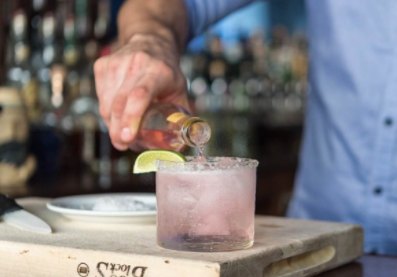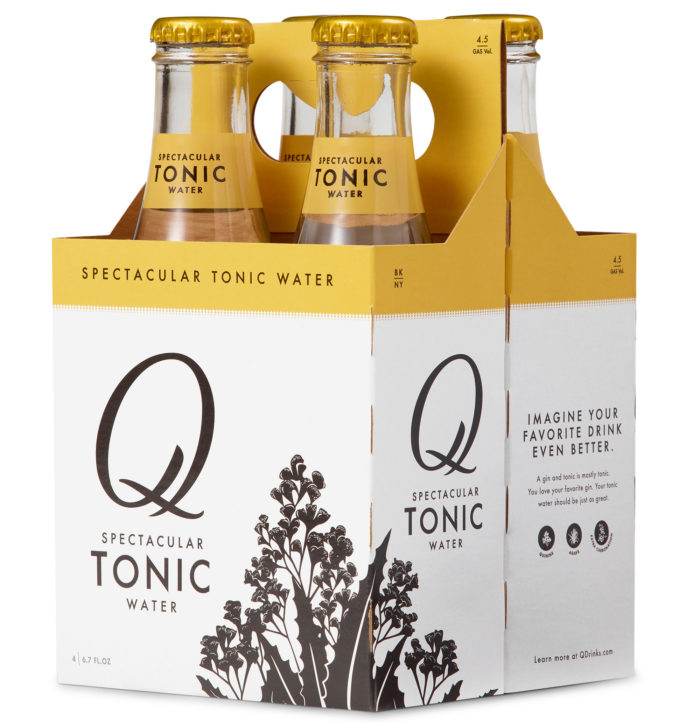What is the Q in Q Drinks, the high-end, Dumbo-based brand of cocktail mixers?
1.) Quality
2.) Quinine (a key ingredient in its first product)
3.) A question
While the correct answer is No. 2, you get partial credit for the others too. In fact, it’s a question from the founder, Jordan Silbert, that led to the launch of the company, namely: “Why can’t my tonic water be as good as my gin?”
After making that rhetorical query, Silbert started up a company that now offers a line of seven products, has 39 employees, and boasts the fastest-growing premium-mixer brand in the U.S.

The Q Drinks lineup has now grown to seven flavors, including two types of tonic water
Next question: What makes Q Drinks different? Turns out the phenomenon is driven by the founder’s own taste buds, with a bit of food science thrown in. His recipes derive from “whatever tastes best,” he told The Bridge. “It needs to be 100% better than what’s out there, otherwise nobody’s going to drink it.”
The idea for Silbert’s company emerged in 2002 on a summer night in Fort Greene, where Silbert, then an executive at the Alliance for Downtown New York, was having drinks in his backyard with friends. A soft breeze was blowing and the walls were decked with fairy lights. Their drink of choice was gin and tonic. The gin was Tanqueray, the favored brand of Silbert’s beloved grandmother.
Before too long, though, something interrupted Silbert’s bliss. “A couple of drinks in, my teeth started getting sticky,” he recalls. Silbert then checked the label of the tonic water, by then almost flat, which contained high-fructose corn syrup and the preservative sodium benzoate. He cross-checked it with a nearby bottle of Sprite, realizing that the tonic water and Sprite had essentially the same ingredients. His friends dismissed his rant, but he did not.
Silbert tried to find a solution. After buying quinine bark online, he started experimenting in his kitchen. His roommate at the time was not too happy about the mess, equating Silbert’s experiments to a makeshift meth lab. But Silbert eventually nailed a formula, and would delight his friends with homemade G&Ts. “It was sharp, crisp and clean, but the bubbles were driving me nuts, because gin and tonic needs to be fizzy,” he said.

Silbert started making the Sparkling Grapefruit mixer as an ingredient for cocktails like the paloma, made with tequila and chopped jalapeno
Silbert soon realized that, in order to take his venture to the next level, he needed an industrial facility to bottle the beverage, and he found one in Western Massachusetts. The tinkering phase lasted a few years. In 2006, he introduced himself to the foodie forum eGullet (you can read his original post here), asking users if they wanted to try his tonic water.
Whether he knew it at the time or not, he nailed the zeitgeist, as it was the dawn of the mixology movement. Mixologist Jim Meehan, then the bartender of Gramercy Tavern–he would later open the popular PDT–asked Silbert to bring some of his tonic water to Gramercy Tavern for a taste test, and put in an order. Likewise, the founder of Milk & Honey had contacted him as well, asking him to deliver after close, meaning after 2:30 a.m. “I borrowed a car, I delivered my first cases at Milk & Honey, and he paid me cash at the register,” recalled Silbert.
Over the next decade, Silbert added more flavors: Ginger Ale, Ginger Beer, Club Soda, Kola, Sparkling Grapefruit, and Indian Tonic Water (designed to pair well with today’s juniper-forward gins). He made his product choices based on what friends and family enjoy–his wife is fond of the tequila-based paloma cocktail, which is why he added grapefruit–and on suggestions from mixologists. “I love your tonic water,” the conversation would go, said Silbert, “but I am embarrassed to have this Schweppes ginger ale next to it. Could you make us, say, a ginger ale?”
Silbert takes what he eats and drinks very seriously, and his seven mixers feature ingredients such as Himalayan salt or exotic spices that, at first glance, might scream hipster affectation. But Silbert, who is also well-versed in the kitchen, tests his recipes with up to 40 trials until he locks down the final formula. Agave nectar is preferred over sugar, for example, due to its complexity and interaction with other ingredients.
Silbert’s ginger ale contains cardamom, orange peel and, perhaps surprisingly, rose oil. In the development process, just going with agave, ginger and quinine made it too “angular,” he said. He was was aiming for a flavor he described as “voluptuous.” When a friend suggested he try rose oil, at first he deemed it more fit for perfumes. And yet, rose oil managed to open up the ginger ale’s flavor.

Q Drinks sells its mixers in fine-food shops but also major chains like Whole Foods
Carbonation is treated as an ingredient as well. All of the flavors, which are manufactured at multiple plants around the U.S., are carbonated at different levels and packaged in specially designed bottles whose thickness allows for more carbonation, which in turn maximizes the flavors of a cocktail.
Premium ingredients don’t come cheap–rose oil, for example, can cost $1,000 per ounce–but in the era of high-end mixology, Q Drinks can charge a premium price. The logic of the sales pitch is a question as well: Why mix your super-premium liquor with a low-end mixer, when that beverage makes up three-quarters of your cocktail?
In a spot check at a Union Market store in Cobble Hill, the price of a 750 ml (25.4 oz) bottle of Q Drinks tonic water was $6.99. The rival London-based Fever-Tree brand was priced slightly lower, at $6.49 for a four-pack of 200 ml bottles. The bargain brand, Vintage, was priced at 99 cents for 1 liter (33.8 oz).
Q Drinks is now sold to 11,000 accounts, including major chains like Whole Foods and Target, as well as high-end restaurants and bars like Blue Hill and Bourbon & Branch. “More and more people are drinking better spirits, paying more attention to them,” said Silbert. He thinks the market for premium mixers has considerable room for growth. “There are better mixers out now than there were ten years ago. Still, as a percentage of total sales, we’re below where similar categories are,” he said.
As with craft beers and liquors, big companies seem likely to get into the action. Coca-Cola CEO James Quincey has singled out mixers as a promising category, Bloomberg reported. “More consumers, most notably adults, are seeking unique and distinct products with sophisticated flavors, quality ingredients and smaller-scale craft production,” Quincey said on a call with analysts. “Mixers are seeing a resurgence in many parts of the world as part of this trend.”
To fuel its growth, Q Drinks has raised money from investors including Pepsi Bottling of the Hudson Valley. In 2016, the company raised $11 million in an investment round led by First Beverage Ventures, the private equity arm of First Beverage Group. At the time, Q Drinks reported revenues in excess of $10 million and rapid growth, which has kept fizzing along. The consulting firm IRI reported that the company’s sales grew more than 46% during the 12-week period ending May 20, making it the fastest-growing premium mixer line in the U.S.
Recently, Silbert has recruited top executives with experience at major beverage companies, including Anheuser-Busch InBev, Campari, and Honest Tea. But even as the company grows, it remains firmly rooted in Brooklyn and its DIY culture. “There are so many people from so many different places, each one being incredibly intense and motivated,” he said. “As a result, there are so many exciting things coming up. Someone in Brooklyn has an idea, they make it happen. I am just an example of that and that makes me proud to be part of that community.”